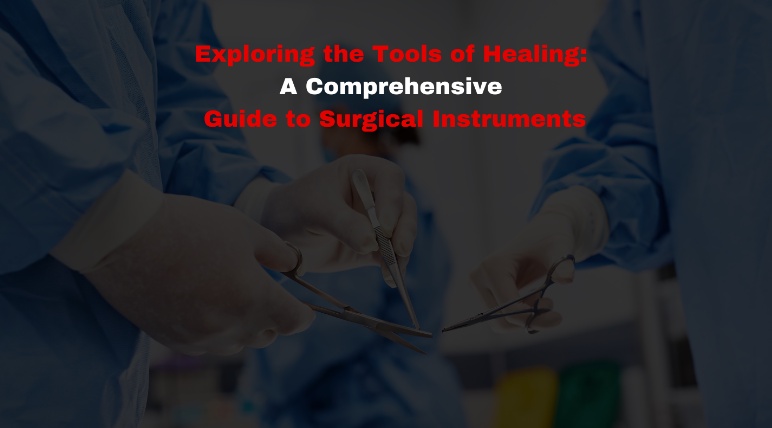Introduction:
Surgery stands as one of the most intricate and demanding fields in medicine, where precise tools are wielded with skill and expertise to diagnose, treat, and heal various medical conditions. At the heart of every successful surgical procedure lies an array of specialized instruments meticulously designed for specific tasks. From scalpels and forceps to retractors and sutures, each instrument plays a pivotal role in the hands of skilled surgeons, contributing to optimal patient outcomes and recovery. In this comprehensive guide, we will delve deep into the world of surgical instruments, exploring their diverse functions, designs, and applications.
- Scalpel:
The scalpel serves as the quintessential surgical tool, embodying precision and finesse in every incision. Comprising a sharp blade attached to a handle, the scalpel allows surgeons to make precise cuts and dissections with unparalleled accuracy. While traditional scalpels feature metal blades, modern variants may incorporate disposable, single-use designs to minimize the risk of infection. Scalpels come in various sizes and shapes, each tailored to specific surgical tasks and anatomical regions.
- Forceps:
Forceps represent indispensable instruments in the surgical armamentarium, facilitating grasping, holding, and manipulation of tissues during procedures. Characterized by two hinged arms with serrated tips, forceps provide surgeons with a firm grip without causing damage to delicate tissues. These versatile instruments come in a myriad of shapes and sizes, ranging from hemostatic forceps for clamping blood vessels to tissue forceps for manipulating various types of tissue with precision.
- Retractors:
Retractors play a vital role in providing optimal visibility and access to the surgical site by holding back tissues and organs. These instruments come in diverse configurations, from handheld retractors to self-retaining systems, each designed to meet the specific needs of surgical procedures. Wound retractors keep incisions open during surgery, while self-retaining abdominal retractors maintain exposure of abdominal organs without constant manual assistance, enabling surgeons to perform complex procedures with ease.
- Surgical Scissors:
Surgical scissors serve as indispensable tools for cutting and dissecting tissues during surgical procedures. Featuring sharp blades with fine tips, these instruments enable surgeons to make precise cuts while minimizing trauma to surrounding tissues. Surgical scissors come in various designs, including straight, curved, and angled blades, each optimized for specific tasks and anatomical regions. Microsurgical scissors with delicate tips find utility in microsurgery and intricate procedures requiring utmost precision.
- Needle Holders:
Needle holders are specialized instruments designed for grasping and manipulating surgical needles during suturing procedures. Equipped with a ratcheted mechanism, needle holders securely hold needles in place, allowing surgeons to suture tissues with accuracy and control. These instruments come in diverse sizes and styles, catering to different needle sizes and suturing techniques. Some needle holders feature tungsten carbide inserts on the jaws for enhanced grip and durability.
- Suction Devices:
Suction devices play a crucial role in maintaining a clear surgical field by removing blood, fluids, and debris from the operative site. These devices comprise a suction tip connected to a vacuum source, enabling surgeons to aspirate fluids and maintain optimal visibility during procedures. Suction devices come in various sizes and configurations, ranging from handheld suction catheters to specialized suction tips designed for specific surgical tasks, ensuring a clean and unobstructed operative field.
- Surgical Sutures:
Surgical sutures, also known as stitches, are essential for closing wounds and incisions after surgical procedures. Available in a variety of materials, including absorbable and non-absorbable options, sutures play a crucial role in wound closure and tissue approximation. Absorbable sutures gradually break down and are absorbed by the body over time, while non-absorbable sutures remain in place indefinitely. Sutures may be classified based on their structure (monofilament vs. multifilament) and configuration (interrupted vs. continuous), with each type serving specific clinical needs.
Conclusion:
Surgical instruments stand as the backbone of modern surgical practice, empowering surgeons to perform intricate procedures with precision and confidence. From the iconic scalpel to the versatile forceps and beyond, each instrument plays a unique role in the surgical process, contributing to successful outcomes and patient recovery. This comprehensive guide has provided an in-depth exploration of essential surgical instruments, shedding light on their functions, designs, and applications. Aspiring surgeons and medical professionals can continue to delve deeper into the fascinating world of surgical instruments, honing their skills and knowledge to advance the field of medicine and deliver exceptional patient care.


No comments yet